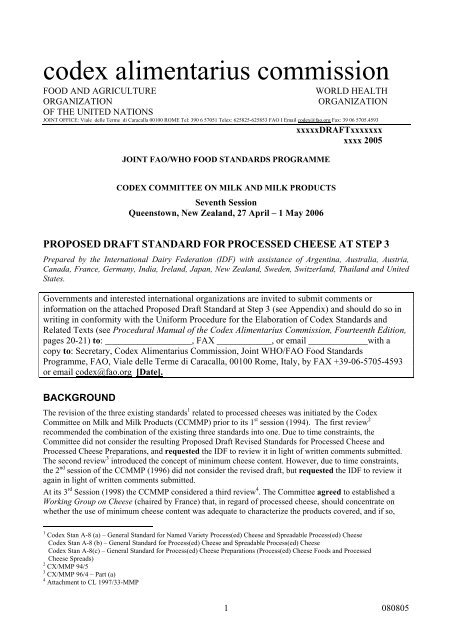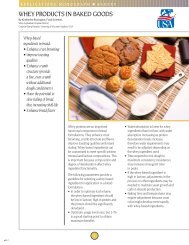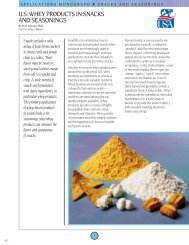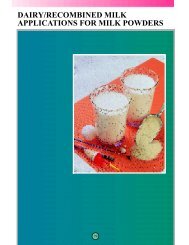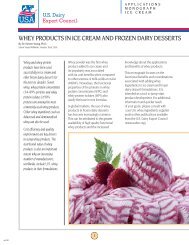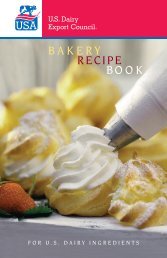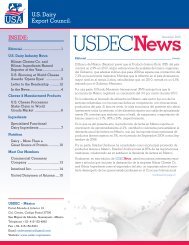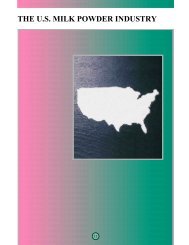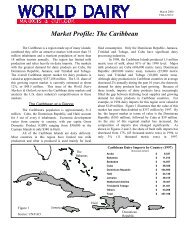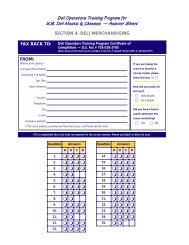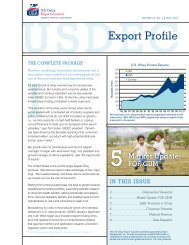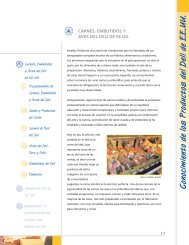codex alimentarius commission
codex alimentarius commission
codex alimentarius commission
You also want an ePaper? Increase the reach of your titles
YUMPU automatically turns print PDFs into web optimized ePapers that Google loves.
<strong>codex</strong> <strong>alimentarius</strong> <strong>commission</strong><br />
FOOD AND AGRICULTURE<br />
ORGANIZATION<br />
OF THE UNITED NATIONS<br />
WORLD HEALTH<br />
ORGANIZATION<br />
JOINT OFFICE: Viale delle Terme di Caracalla 00100 ROME Tel: 390 6 57051 Telex: 625825-625853 FAO I Email <strong>codex</strong>@fao.org Fax: 39 06 5705.4593<br />
xxxxxDRAFTxxxxxxx<br />
xxxx 2005<br />
JOINT FAO/WHO FOOD STANDARDS PROGRAMME<br />
CODEX COMMITTEE ON MILK AND MILK PRODUCTS<br />
Seventh Session<br />
Queenstown, New Zealand, 27 April – 1 May 2006<br />
PROPOSED DRAFT STANDARD FOR PROCESSED CHEESE AT STEP 3<br />
Prepared by the International Dairy Federation (IDF) with assistance of Argentina, Australia, Austria,<br />
Canada, France, Germany, India, Ireland, Japan, New Zealand, Sweden, Switzerland, Thailand and United<br />
States.<br />
Governments and interested international organizations are invited to submit comments or<br />
information on the attached Proposed Draft Standard at Step 3 (see Appendix) and should do so in<br />
writing in conformity with the Uniform Procedure for the Elaboration of Codex Standards and<br />
Related Texts (see Procedural Manual of the Codex Alimentarius Commission, Fourteenth Edition,<br />
pages 20-21) to: ___________________, FAX ____________, or email _____________with a<br />
copy to: Secretary, Codex Alimentarius Commission, Joint WHO/FAO Food Standards<br />
Programme, FAO, Viale delle Terme di Caracalla, 00100 Rome, Italy, by FAX +39-06-5705-4593<br />
or email <strong>codex</strong>@fao.org [Date].<br />
BACKGROUND<br />
The revision of the three existing standards 1 related to processed cheeses was initiated by the Codex<br />
Committee on Milk and Milk Products (CCMMP) prior to its 1 st session (1994). The first review 2<br />
recommended the combination of the existing three standards into one. Due to time constraints, the<br />
Committee did not consider the resulting Proposed Draft Revised Standards for Processed Cheese and<br />
Processed Cheese Preparations, and requested the IDF to review it in light of written comments submitted.<br />
The second review 3 introduced the concept of minimum cheese content. However, due to time constraints,<br />
the 2 nd session of the CCMMP (1996) did not consider the revised draft, but requested the IDF to review it<br />
again in light of written comments submitted.<br />
At its 3 rd Session (1998) the CCMMP considered a third review 4 . The Committee agreed to established a<br />
Working Group on Cheese (chaired by France) that, in regard of processed cheese, should concentrate on<br />
whether the use of minimum cheese content was adequate to characterize the products covered, and if so,<br />
1 Codex Stan A-8 (a) – General Standard for Named Variety Process(ed) Cheese and Spreadable Process(ed) Cheese<br />
Codex Stan A-8 (b) – General Standard for Process(ed) Cheese and Spreadable Process(ed) Cheese<br />
Codex Stan A-8(c) – General Standard for Process(ed) Cheese Preparations (Process(ed) Cheese Foods and Processed<br />
Cheese Spreads)<br />
2 CX/MMP 94/5<br />
3 CX/MMP 96/4 – Part (a)<br />
4 Attachment to CL 1997/33-MMP<br />
1 080805
identification of the relevant minimum contents, and if not adequate, provide guidance on an alternative<br />
approach.<br />
The Working Group on Cheese presented the results of its considerations 5 to the 4 th Session (2000). The<br />
Chair of the Working Group indicated that the WG was not able to provide additional recommendations to<br />
those already provided in the report in regard to the minimum cheese content that would be required or the<br />
way it would be expressed in the proposed draft revised Codex Standard for Processed Cheese and<br />
recommended that alternative solutions be sought on these issues, particularly on the basis of two proposals<br />
provided in the report. The Committee agreed to further examine the prospect of establishing an absolute<br />
minimum cheese content for processed cheeses or alternative approaches and decided to obtain additional<br />
information and data on minimum cheese contents in processed cheeses as well as comments on the two<br />
alternative proposals identified. It was further agreed that France, the United States and IDF would collate<br />
and present the information to the 5 th session of the Committee.<br />
At its 5 th Session (2002), the CCMMP was informed that the replies to the questionnaire 6 showed that<br />
specification of a minimum content of cheese in processed cheese and processed cheese preparation was not<br />
generally practiced and did not provide explicit support to either of the two proposals. Therefore, the<br />
Committee examined alternative approaches as identified by IDF 7 .<br />
The Committee agreed on the need to establish a standard for Processed Cheese only (excluding Processed<br />
Cheese Products and Preparations). It established a Drafting Group led by the IDF with the assistance of<br />
Argentina, Australia, Austria, Canada, France, Germany, India, Iran, Ireland, New Zealand, Switzerland,<br />
United Kingdom and United States to prepare a proposed draft Standard for Processed Cheese by using<br />
definitions that will specify ingredients and processing techniques, with consideration given to the inclusion<br />
of some supplementary compositional criteria and with labelling provisions for cheese content for consumer<br />
information. The Committee agreed that a minimum cheese content should not be specified in the standard.<br />
The 26 th Session of the Codex Alimentarius Commission (2003) approved the elaboration of a Standard for<br />
Processed Cheese as a new work item.<br />
The first draft standard for Processed Cheese, as elaborated by the Drafting Group 8 , was considered by the<br />
6 th Session of the CCMMP in CX/MMP 04/7. The Committee noted that the key problem in further<br />
development of Standard was to get consensus on the general approach, especially on the description and the<br />
source of raw materials to be used in processed cheese production, and that some additional work to solve<br />
this issue was still needed. While there was a suggestion to discontinue the work on this agenda item, other<br />
delegations pointed out that the standard was important and that the document was a good starting point for<br />
further elaboration. It was proposed to consider developing provisions for processed cheeses with a low fat<br />
content, with no minimum fat level set to encourage the development of products with lower fat, and to<br />
specify that cheese should constitute the largest single ingredient in the product so as to not mislead<br />
consumers.<br />
The Committee agreed to return the Proposed Draft Standard to Step 2 for redrafting by a (new) Drafting<br />
Group led by IDF with assistance of Argentina, Australia, Austria, Canada, France, Germany, India, Ireland,<br />
Japan, New Zealand, Sweden, Switzerland, Thailand and United States on the basis of the discussion and<br />
written comments submitted at the current Session. The revised document would be circulated for comments<br />
at Step 3 and consideration at the 7 th Session of the Committee.<br />
PROPOSED DRAFT STANDARD<br />
The Drafting Group met in Brussels (BE) on the 21-22 September 2004 and again in Cologne (DE) on the<br />
27-28 June 2005. The resulting redrafted Proposed Draft Standard for Processed Cheese is attached to this<br />
document.<br />
The Drafting Group recognized that, in spite of the seeming inherent weaknesses in the drafting of the<br />
existing standards A8 (a), (b) and (c), currently (or in recent past) no problems in international trade existed<br />
with regard to processed cheese. It concluded that the redrafting should concentrate on processed cheese in<br />
5 CX/MMP 00/7<br />
6 Circulated with CL 2001/20-MMP<br />
7 Conference Room Document (CRD) 13<br />
8 CX/MMP 04/7<br />
2 080805
general, i.e. within the scope of current standard A-8 (b)) with the inclusion of provisions, where appropriate,<br />
relating to named variety processed cheeses.<br />
This report provide brief explanatory material related to each of the individual sections of the redraft, in<br />
particular the rationale(s) that led the Drafting Group to conclude on the various sections and any major<br />
considerations involved in their development.<br />
SECTION 1 - SCOPE OF THE STANDARD<br />
Because of the exact nature of the various products covered by the existing standards A-8 (a), (b) and (c)<br />
differ between countries, it proved difficult, in practice, to implement the decision of the 5 th Session to draft a<br />
standard for Processed Cheese only, while effectively excluding other similar products/designations. During<br />
the many years of drafting, the various drafting parties have mainly focused on technical descriptions and<br />
compositional requirements when attempting to clarify borderlines between “Processed Cheese” and the<br />
other products, whereas additional distinguishing according to labelling was not explored in any detail.<br />
According to a survey conducted by the IDF in 1995 9 , national legislation includes a wide number of official<br />
or officially recognized designations, which may be alternatives to, overlap with, or be different from the<br />
various products described in the existing standards A-8 (a), (b) and (c).<br />
Inspired by the current approach to the C-standards, the Drafting Group came to the conclusion that putting<br />
emphasis in the scope on the fact that the standard apply only, if the name Processed Cheese is actually used<br />
as a designation, provides an element additional to the technical descriptions and criteria specified. This will<br />
assist in clarifying the borderlines between products covered by the standard and those that are not.<br />
Consequently, the aim of the standard will then be to specify the provisions applying to the product<br />
designation “Processed Cheese”.<br />
The text of the scope has been redrafted accordingly, and a note explaining that other designations (such as<br />
those currently defined by national legislation and/or by the existing Codex standard A-8(c)), are outside the<br />
scope of the redrafted standard.<br />
SECTION 2 - DESCRIPTION<br />
Description of Processed Cheese<br />
The Drafting Group thoroughly considered and discussed the provisions and intentions of the existing<br />
standards A-8, and conducted a brainstorming exercise to identify the key essentials of Processed Cheese,<br />
resulting in the following:<br />
Key technological essentials:<br />
• Melting of para-casein 10 or casein in cheese (A-6), by heat in combination with emulsifying salts or just by<br />
heat, in a well-mixed medium<br />
• Melting of milk fat (if present) by heat<br />
• Emulsification of fat, protein and water present in the cheese as well as added water and other (non-cheese)<br />
milk products and milk components, through the aid of heat, in some cases in combination with emulsifiers<br />
Essential end product characteristics:<br />
• Solid/semi-solid (i.e. not a liquid)<br />
• Spreadable/sliceable texture<br />
• Homogenous and smooth appearance<br />
• Stable oil-in-water emulsion (gel)<br />
Key semantic issues/issue of principle (related to the use of the term cheese in the name):<br />
• Cheese being present or being the largest/or important ingredient<br />
Recognizing that the part (a) and (b) approach followed hitherto was not really helpful or necessary, a new<br />
definition was drafted from scratch on the basis of the above key essentials.<br />
9 See CX/MMP 96/4, Part (a)<br />
10 Note: Para-casein only occurs in rennet coagulated cheeses, not in acid or heat coagulated cheeses<br />
3 080805
Description of Named Variety Processed Cheese<br />
The Drafting Group considered the most appropriate location of the provisions and criteria relating to Named<br />
Variety Processed Cheeses and considered that the best approach is to address named variety provisions<br />
throughout the standard in the relevant sections. In order to provide an umbrella for this approach, a<br />
description is needed (binding together the various provisions).<br />
The description specifies the two basic conditions that constitutes the concept of this sub-category of<br />
Processed Cheese, i.e.<br />
(i) that the variety(ies) is(are) actually used as raw material in the manufacture of the Processed Cheese<br />
and<br />
(ii) that the variety name(s) is(are) referenced in the designation. In other words, a product made from (a)<br />
recognized cheese variety(ies), but without these names being referenced in the designation, do(es) not<br />
belong to this sub-category.<br />
This description, together with the specified compositional and naming requirements in sections 3.1 and<br />
7.1.4, respectively, constitutes the special requirements for Named Variety Processed Cheese.<br />
SECTION 3.1 – RAW MATERIALS<br />
Re: Indents (a)-(c) (raw material categories)<br />
Raw materials for Processed cheese have been categorized into three categories, as follows:<br />
a) Cheese, i.e. all milk products that fall under the scope of Standard A-6, whether ripened, unripened, or in<br />
brine; whether coagulated by the action of rennet, by other coagulating enzymes, by acid or by heat; and<br />
with any fat and moisture combination. The cheese can be manufactured at a different establishment or<br />
be manufactured at the same establishment in the course of a combined process of manufacturing cheese<br />
and subsequently processed cheese<br />
b) Milk products rich in fat, i.e. products that are primarily added for upwards standardization of the fat<br />
content of the ingoing raw materials (e.g. cheese with relatively low fat content) to meet the desired fat<br />
content of the final product (e.g. processed cheese with full fat content)<br />
c) Milk and milk products other than cheese and milk products rich in fat, i.e. products that are primarily<br />
added for downwards standardization of the fat content and/or standardization of the (fat free) dry matter<br />
content of the ingoing raw materials to meet the desired composition of the final product (e.g. to produce<br />
low fat processed cheese). The moisture and fat contents of the raw materials belonging to this category<br />
vary, influencing required amounts of category (b) products and of water.<br />
Re: 1 st paragraph (cheese content)<br />
Recognizing that the new definition specifies that cheese must be present, various direct and indirect ways of<br />
controlling the ingoing amount were considered very thoroughly at both meetings, including:<br />
• specifying a minimum level of ingoing cheese<br />
• regulating the ingoing amounts of category (b) and (c) materials, only<br />
• specifying the ratio of cheese relative to the other ingoing categories<br />
• regulating the content of all three categories (a min. for cheese, a max. for each of the two other<br />
categories)<br />
• establishing a maximum limit for fat in dry matter (to indirectly control the relative amount of ingoing<br />
milk fat, not derived from cheese)<br />
• limiting the increase (in end product) of certain milk components (e.g. protein, dry matter) resulting from<br />
the addition of ingoing category (b) and/or (c) materials<br />
• limiting the amount of fat-free dry matter coming from category (c) products<br />
The above mechanisms differ in terms of complexity, which need to be taken into account in the desire not to<br />
draft a standard that is more complicated than necessary.<br />
Further, during the elaborations, it became apparent that the difficulties in obtaining consensus mostly<br />
related to products with relative high moisture content in combination with a relative high fat content (high<br />
fat spreadable products). The Drafting Group thoroughly reconsidered the situation, an in order to obtain<br />
international consensus on this Standard, agreed to develop compositional criteria for a base-line product<br />
4 080805
(“processed cheese”), while granting certain additional flexibility to spreadable products, using simple<br />
mechanisms to control the amount of ingoing cheese.<br />
The outcome of the various considerations was the following “packages” of elements that together control<br />
the amount of cheese used:<br />
Location in<br />
standard:<br />
Section 2<br />
Section 3.1<br />
Section 3.3<br />
Section 7.1.4<br />
Section 7.3<br />
“Processed Cheese” (unqualified)<br />
(i.e. the “base-line”)<br />
The product is to be obtained from and<br />
by melting cheese<br />
Cheese shall constitute the largest<br />
category among the three categories<br />
specified 11<br />
The fat in dry matter content shall be<br />
max. 75%<br />
The ingoing cheese content (% of the<br />
formulation) shall be declared if so<br />
required in the country of retail sale<br />
“Processed Cheese”, qualified as “spreadable”<br />
The product is to be obtained from cheese and by melting<br />
cheese<br />
Cheese and milk products rich in fat may, in combination,<br />
constitute the largest category among the three categories<br />
specified provided that 12<br />
- the fat in dry matter content is higher than 50% (w/w)<br />
- the product still complies with the description in section 2<br />
- the end product designation is qualified as “spreadable”<br />
The fat in dry matter content shall be max. 75%<br />
Where this Standard requires the use of the qualifier<br />
“spreadable”, the term shall be stated in conjunction with the<br />
name “Process(ed) Cheese”<br />
The ingoing cheese content (% of the formulation) shall be<br />
declared if so required in the country of retail sale<br />
In addition to the above, the Drafting Group considered various additional criteria to control the relative<br />
ratios between the ingoing categories. The options suggested during the discussions included:<br />
i) Specifying a maximum level of ingoing category (c) materials (e.g. 10%) for all products.<br />
It was recognized that the identification of the appropriate maximum figure for category (c) material<br />
would be quite complicated due to the large compositional variation that is represented within these<br />
types of raw materials, and that such limitation may limit options for the marketing of low fat processed<br />
cheese (due to limited supply of low fat cheeses available for processing).<br />
ii) Specifying a minimum fat content of the cream added as category (b) material (e.g. 30%) for all products<br />
The establishment of a min. fat content for creams belonging to category (b) would automatically mean<br />
that creams below such a content would fall under category (c) materials. To assist in further<br />
consideration of this option, the Drafting Group requested the IDF to investigate which fat contents of<br />
cream are typically used for upwards fat standardization in the manufacture of processed cheese.<br />
Following the meeting, the IDF reported as follows:<br />
[TO BE INSERTED, WHEN AVAILABLE]<br />
iii) For products qualified as spreadable, restricting the addition of ingoing category (b) materials to the<br />
amount required to standardize (top up) the fat content greater than 40% (i.e. beyond the full fat level).<br />
This would mean that for instance, the amount of e.g. butteroil used to standardize the FDM content -<br />
from the content of the ingoing blend of cheese and category (c) materials up to 40% - shall, in<br />
combination with the added amount of cheese, constitute the largest category of raw materials. The<br />
additional butteroil used to standardize the FDM content from 40% up to the desired final fat content<br />
11 This means that products named as “Processed Cheese” (unqualified) shall consist of minimum approx. 34% cheese (of ingoing<br />
raw materials). It should be noted that the percentage of ingoing raw materials is not the same as the percentage of the final product,<br />
nor the same as the percentage that may have to be declared according to section 7.3 of the Standard. The difference between these<br />
percentages will depend on the amount of added permitted ingredients (section 3.2) and of additives (section 4) as well as on the<br />
amount of moisture added through category (b) & (c) materials and as water, respectively.<br />
12 The additional flexibility granted can only be utilized if the product is a suitable for spreading (section 7.1.4) and if it is qualified<br />
as “spreadable”. However, a spreadable texture does not necessarily depend on moisture content. Products, the texture of which are<br />
spreadable (e.g. due to use of fully ripened cheese material), but for which the additional flexibility is not utilized, can also be<br />
qualified as “spreadable”, but such qualification will be optional. A Processed Cheese with FDM contents below 50% shall respect<br />
the raw material requirements for the “base-line” product – also if the product is qualified as “spreadable”.<br />
5 080805
above 50% FDM 13 would belong to category (c) materials. This approach will facilitate the use of<br />
low/reduced fat cheeses in the manufacture of high fat spreadable processed cheeses and will avoid<br />
extreme combinations of category (a) and (b) materials (for instance, the extreme of 99% butteroil, 1%<br />
cheese).<br />
The Drafting Group did not come to a final conclusion on this issue, but agreed on the temporarily inclusion<br />
of option (iii) in square brackets.<br />
Consideration of additional ”special cases”<br />
The Drafting Group also discussed whether there was a need for granting similar (or different) flexibility for<br />
other categories of Processed Cheese. One particular case considered was processed cheeses with relatively<br />
low fat contents. The following wording for these products was considered:<br />
“In the case of Process(ed) Cheese with a content of fat in dry matter below 20% (m/m), raw materials<br />
of categories (a) and (c) may, in combination, constitute the largest category, provided that the end<br />
product designation is qualified as .........(qualifier to be identified)..........”<br />
However, as no information was available to the Drafting Group as to whether such flexibility was actually<br />
needed, it was concluded, at present, not to include such wording<br />
Re: 2 nd paragraph (named variety processed cheese)<br />
It is obvious that establishing the figure specifying the min. amount of variety(ies) on the basis of ingoing<br />
milk products is more consistent than the existing approach (75% of ingoing cheese) referring to “a moving<br />
target”.<br />
Therefore, the Drafting Group agreed that it would be more appropriate, more transparent, and would<br />
provide better means of control, if the minimum amount of variety cheese were expressed in relation to all<br />
ingoing milk products.<br />
In converting the current minimum level expressed on the basis of ingoing cheese (current figure of 75%) to<br />
ingoing milk products, the min. figure will necessarily have to be less than 75% - otherwise, the criterion<br />
would be more restrictive than the current one.<br />
A limited survey of existing products that currently were on the market showed:<br />
• That the range of cheese varieties added depends on the country and on the type of processed cheese;<br />
Varieties include Cheddar, Camembert, Gouda, Colby, Edam, Blue cheese, Brie, Camembert, goats milk<br />
varieties, Grevé, Mozzarella and others.<br />
• That amounts added also vary depending on the PC being manufactured; For example:<br />
- where the variety added is the major component in PC, amounts added range 50-90%,<br />
- where only a single variety is used the amount is greater than 50%, and<br />
- where 2 or more varieties of cheese are used the amount of each ranges from 22% to 63%.<br />
• That where the variety is not the major component (or appears not to be the major component) amounts<br />
are much lower, 1%-17%. In these cases, the amount added relate to the intensity of flavour, and only a<br />
small quantity is required to be added to achieve the characteristic flavour. Greater amounts would result<br />
in too much flavour.<br />
From the data collected, it seems that PC tend to fall into two major groups:<br />
- Firstly, products, where the amount of variety cheese(s) (or where more than one is added, the<br />
combination) constitute(s) at least 50% (some >60%) and<br />
- Secondly, products, where the amount typically constitutes much less than 50%.<br />
On the above basis, the Drafting Group concluded that there is a need for the Standard to accommodate both<br />
situations by addressing compositional requirements for high variety content PC (i.e. named variety<br />
processed cheeses) in section 3.1 and to include a labelling provision for PC with lower variety content (see<br />
Section 7.1.5).<br />
Assuming a total cheese content of 80%, it was roughly calculated that a conversion of the existing criterion<br />
(75% of ingoing cheese blend) into a criterion based on ingoing milk products results in a min. figure of<br />
13 This provision only applies to Processed Cheese qualified as "spreadable" and with FDM contents above 50%<br />
6 080805
approx. 60%. However, as the Drafting Group considered that such a figure needed further consultation with<br />
stakeholders, it agreed to retain the figure of 60% in square brackets.<br />
SECTION 3.2 – PERMITTED INGREDIENTS<br />
The Drafting Group took note of the recent clarification by CCFAC that salt substitutes do not belong to a<br />
functional additives class and decided to include potassium chloride as a permitted ingredient.<br />
With regard to gelatine and starch, the wording was square bracketed, pending clarification of whether the<br />
additives section will include stabilizers and thickeners. If the additives section will not include these<br />
functional classes, the provision for these ingredients will be removed as a consequence, whereas if the<br />
conclusion on additives is that stabilizers and/or thickeners are technologically justified for processed cheese<br />
or sub-categories thereof, gelatine and starch will be equally justified and the square brackets will have to be<br />
lifted.<br />
SECTION 3.3 – COMPOSITION<br />
Both the former and the current Drafting Group thoroughly considered a number of parameters 14 for<br />
inclusion as compositional criteria for Processed Cheese, and concluded that only criteria for minimum dry<br />
matter contents and for an absolute maximum content of FDM should be specified.<br />
The Drafting Group agreed that Processed Cheese qualified as “spreadable” should be granted lower<br />
minimum requirements for dry matter contents 15 .<br />
The format of presenting these requirements has been copied from the draft C-standards.<br />
The Drafting Group requested the IDF to suggest the specific numerical values.<br />
Following the meeting, the IDF reported as follows:<br />
[TO BE INSERTED, WHEN AVAILABLE]<br />
SECTION 4 – FOOD ADDITIVES<br />
The Drafting Group agreed to use the new approach of the CCMMP to address food additive provisions<br />
through establishing a table that specifies which functional classes of additives are technologically justified<br />
for which sub-categories of products and to supplement the table with the corresponding lists of additives<br />
(for each functional class), based on described technological justifications (class + individual additives with<br />
numerical ADIs), and by using the approach followed by the CCMMP for Fermented Milk.<br />
The Drafting Group requested the IDF to develop recommendations for additive provisions.<br />
Following the meeting, the IDF reported as follows:<br />
[TO BE INSERTED, WHEN AVAILABLE]<br />
14 The other criteria considered were:<br />
Maximum moisture content: Not included, as it is similar to minimum dry matter content.<br />
Minimum milk protein content: Not included, as it is not related to cheese content, as a provision for declaration of milk protein in<br />
the labeling section was preferred (see section 7.4), as this issue has not yet been settled by the<br />
CCMMP in respect of cheese, and as a max. amount of FDM indirectly implies a min. amount of<br />
protein (a max 25% of the dry matter constituents must be protein, lactose, salt and additives and that<br />
the amounts of the latter three are self-limiting)<br />
Maximum lactose content: Not included, as (i) the content is self-limiting for technological reasons (crystallization), (ii) a limit<br />
will not in any way restrict type of raw materials, and (iii) a limit does not affect consumption<br />
patterns of individuals with lactose intolerance.<br />
Whey protein to casein ratio: Not included, as a ratio is not relevant for product identity, nutrition or consumer information.<br />
15 It should be noted that the additional flexibility provided in Section 3.3 is independent from the additional flexibility granted in<br />
Section 3.1 with respect to cheese content. This means that a manufacturer qualifying the designation as “spreadable” can choose<br />
among the following:<br />
- utilizing the flexibility given in Section 3.1, but not the flexibility given in Section 3.3<br />
- utilizing the flexibility given in Section 3.3, but not the flexibility given in Section 3.1<br />
- utilizing the flexibility given in Section 3.1, as well as the flexibility given in Section 3.3<br />
7 080805
SECTION 5 – CONTAMINANTS<br />
Since no Codex maximum levels are currently specified for Processed Cheese (or for that matter any other<br />
milk product), but only for milk, the Drafting Group used the text currently included in the Draft Standards<br />
for Cheddar and Danbo.<br />
SECTION 6 – HYGIENE<br />
The text included in all other revised milk products standards has been used.<br />
SECTION 7.1 – NAME OF THE FOOD<br />
This section is made up of 5 sub-provisions all of which relate to the designation of processed cheese.<br />
Section 7.1.1 (general provision):<br />
The text is equivalent to the text in most other revised milk products standards.<br />
Alternatively, and in order to correspond better with the scope of this Standard, the CCMMP could consider<br />
to use wording similar to the wording currently used in the Draft Standards for Cheddar and Danbo, i.e.:<br />
“The name Process(ed) Cheese may be applied in accordance with section 4.1 of the Codex General<br />
Standard for the Labelling of Prepackaged Foods, provided that the product is in conformity with this<br />
Standard.”<br />
Section 7.1.2 (placing on the label of the qualification “spreadable"):<br />
One of the conditions for utilizing the additional flexibilities granted in sections 3.1 and 3.3, respectively, is<br />
that the name is qualified as “spreadable”. The text states that such qualification shall be placed in<br />
conjunction with the name.<br />
It should be noted that spreadable products that contain < 50% FDM or do not utilize these additional<br />
flexibilities (e.g. >34% cheese) can still state the qualification “spreadable” on the label, however, the<br />
placing of the terms can be made anywhere on the label and not necessarily in conjunction with the name of<br />
the food.<br />
Section 7.1.3 (meaning of the term “spreadable”)<br />
One of the conditions for utilizing the additional flexibilities granted in sections 3.1 and 3.3 is that the<br />
product has a spreadable texture. The provision Section 7.1.3 is needed to:<br />
- ensure that only products with a spreadable texture can utilize the additional flexibilities provided, and<br />
- ensure that the term “spreadable” optionally can be stated on the label for any Processed Cheese that has<br />
a spreadable texture (including products with FDM contents
Putting emphasis on a particular ingredient in the designation of a food falls under the Codex definitions of a<br />
“claim” 16 . Such practice is not prohibited unless the claim is misleading (i.e. is not false).<br />
The issue relevant for the standard for Processed Cheese is that, according to these definitions of “claim”,<br />
putting emphasis on presence of e.g. Emmental in Processed Cheese is acceptable, also if the amount used is<br />
less than the minimum required for the special category of Named Variety Processed Cheese ([60%]).<br />
The Drafting Group considers that there is a need for the standard to address such practice. The Group<br />
considered that doing nothing would not prohibit putting special emphasis to low amounts of variety cheese<br />
anyway, neither would it ensure that such names will not confused with names of Named Variety Processed<br />
Cheese. Further, it would not be in accordance with current practice to insert a statement that would prohibit<br />
putting any emphasis unless the minimum amount specified for Named Variety Processed Cheese was met.<br />
SECTION 7.2 DECLARATION OF MILK FAT CONTENT<br />
The text is the same as the one used in the General Standard for Cheese (A-6).<br />
SECTION 7.3 DECLARATION OF CHEESE CONTENT<br />
After having considered section 5.1 of the Codex General Standard for the Labelling of Prepackaged Foods<br />
(Codex Stan 1), the Drafting Group has agreed that the most consistent approach is to refer to the declaration<br />
of the ingoing percentage of cheese in the formulation. This approach also puts emphasis on the means to<br />
verify compliance, i.e. through checking the recipe and not through analyzing the end product. 17<br />
Views differ with regard to a possible reference to national legislation. Therefore, it has been found<br />
appropriate to refer to requirements in the country of retail sale with respect to the need for such declaration.<br />
SECTION 7.4 DECLARATION OF MILK PROTEIN CONTENT<br />
The wording is consistent with the wording used in other CCMMP standards where provisions for protein<br />
declaration have been included.<br />
SECTION 7.5 LABELLING ON NON-RETAIL CONTAINERS<br />
The wording is consistent with the wording used in other CCMMP standards.<br />
SECTION 8 METHODS OF SAMPLING AND ANALYSIS<br />
The wording is consistent with the wording used in other CCMMP standards.<br />
The CCMMP should note that the draft standard requires the use of appropriate methods for the following:<br />
- Determination of (milk-based) dry matter content<br />
- Determination of milk fat content (to calculate fat in dry matter content)<br />
- Determination of milk protein content<br />
Verification of cheese content, including named varieties, is to be carried out through checking the recipe<br />
and not through analyzing the end product.<br />
16 A “claim” is any representation which states, suggests or implies that a food has particular characteristics relating to its origin,<br />
nutritional properties, nature, production, processing, composition or any other quality (Section 2 of General Guidelines on Claims -<br />
CAC/GL 1-1979 (Rev. 1-1991)<br />
“Claim” means any representation which states, suggests or implies that a food has particular qualities relating to its origin,<br />
nutritional properties, nature, processing, composition or any other quality (Section 2 of the GSLPF - CODEX STAN 1-1985 (Rev.<br />
1-1991)<br />
17 It should be noted that the percentage that may have to be declared according to this section is not the same as the percentage of<br />
ingoing raw materials specified in section 3.1 nor is the same as the percentage of the final product. The difference between these<br />
percentages will depend on the amount of added permitted ingredients (section 3.2) and of additives (section 4) as well as on the<br />
amount of moisture added through category (b) & (c) materials and as water, respectively.<br />
9 080805
RECOMMENDATION TO THE 7TH SESSION OF THE CCMMP<br />
The Committee is invited to review the attached Draft Proposed Standard for Process(ed) Cheese and to<br />
consider its further development.<br />
Further, the Committee is invited to consider and, as appropriate, to implement the recommendations of the<br />
IDF (to be reported separately) with regard to:<br />
Section 3.1: Typical fat contents of cream for upwards fat standardization of Processed Cheese<br />
Section 3.3: Figures for minimum dry matter contents<br />
Section 4: Additive provisions<br />
10 080805
Attachment<br />
REDRAFT OF PROPOSED DRAFT STANDARD FOR PROCESS(ED) CHEESE<br />
1. Scope<br />
(At Step 3 of the Codex Procedure)<br />
This Standard applies only to products that are named Process(ed) Cheese (including<br />
named variety (ies) process(ed) cheese) intended for direct consumption or further<br />
processing, in conformity with the description in Section 2 of this Standard 1 .<br />
2. Description<br />
Process(ed) Cheese is the semi-solid and speadable to solid and sliceable milk product<br />
obtained from cheese (CODEX STAN A-6), with or without the addition of other milk<br />
products, by melting* the cheese (A-6) in a well-mixed medium and emulsifying* the fat,<br />
protein, and water in the cheese added water and the other milk products present with the<br />
aid of heat, to produce a homogenous, smooth and stable oil-in-water emulsion.<br />
*) Normally with the aid of emulsifying salts.<br />
Named variety(ies) process(ed) cheese is processed cheese, as defined above,<br />
characterized by the use in its manufacture of one or more recognized varieties of cheese,<br />
and a reference to these in the designation (e.g. Process(ed) Cheddar Cheese, Cheddar<br />
Process(ed) Cheese, Process(ed) Cheddar).<br />
3. Essential Composition and Quality Factors<br />
3.1 Raw Materials<br />
a) Cheese*<br />
b) Milk products rich in fat (e.g. butter*, butteroil*, ghee*, cream*)<br />
c) Milk and milk products other than the above (e.g. milk concentrates, buttermilk, milk<br />
powders*, milk proteins, whey powders*, lactose*)<br />
Of the above three categories of raw materials, cheese shall constitute the largest category.<br />
However, in the case of Process(ed) Cheese with a content of fat in dry matter higher than<br />
50% (m/m), categories (a) and (b) may, in combination, constitute the largest category,<br />
provided that<br />
- [category (b) materials are only added to top up FDM levels beyond 40%,]<br />
- the product still complies with the description in Section 2, and that<br />
- the end product designation is qualified as “spreadable”.<br />
The cheese variety(ies) referenced in the designation of named variety(ies) process(ed)<br />
cheese shall constitute at least [60] % (m/m) of the ingoing milk products<br />
*) For further details, see relevant Codex standards<br />
3. 2 Permitted Ingredients<br />
- Sodium chloride;<br />
- Potassium chloride;<br />
- Water;<br />
1<br />
This standard does not cover products that are named with other designations such as” processed cheese<br />
preparation”, “processed cheese product”, “processed cheese spread”, “processed cheese food”, “processed cheese<br />
speciality” and “processed cheese dessert”.<br />
11
Attachment<br />
- [Gelatine and starches: these substances can be used in the same function as<br />
stabilizers, provided they are added only in amounts functionally necessary as<br />
governed by Good Manufacturing Practice taking into account any use of the<br />
stabilizers/thickeners listed in section 4]; and<br />
- Vinegar.<br />
3. 3. Composition<br />
Milk constituent: Minimum content (m/m); Maximum content (m/m):<br />
Milk fat in dry matter: None 75%<br />
Dry matter:<br />
Depending on the fat in dry matter content according to the table<br />
below.<br />
Process(ed)<br />
Cheese<br />
Process(ed)<br />
Cheese qualified<br />
as “spreadable"<br />
Equal to or above 30% but less than 50%: [..*.] [..*.]<br />
Equal to or above 50% but less than 75%: [..*.] [..*.]<br />
Less than 30%: [..*.] [..*.]<br />
[*Recommendations for the DM figures to be reported separately by the IDF]<br />
4. Food Additives<br />
[List of technologically justified functional additives classes within a table approach<br />
and corresponding lists of additives to be reported separately by the IDF]<br />
5. Contaminants<br />
The milk used in the manufacture of the products covered by this Standard shall comply<br />
with the maximum limits for contaminants and the maximum residue limits for pesticides<br />
and veterinary drugs established by the Codex Alimentarius Commission.<br />
6. Hygiene<br />
6. 1 It is recommended that the products covered by the provisions of the standard be prepared<br />
and handled in accordance with the appropriate Sections of the Recommended<br />
International Code of Practice – General Principles of Food Hygiene (CAC/RCP 1-1969,<br />
Rev. 3-1997), and other relevant Codex texts such as Codes of Hygienic Practice and<br />
Codes of Practice.<br />
6.2 From raw material production to the point of consumption, the products covered by this<br />
Standard should be subject to a combination of control measures, which may include, for<br />
example pasteurisation, and these should be shown to achieve the appropriate level of<br />
public health protection.<br />
6.3 The products should comply with any microbiological criteria established in accordance with<br />
the Principles for the Establishment and Application of Microbiological Criteria for Foods<br />
(CAC/GL 21-1997).<br />
7. Labelling<br />
In addition to the provisions of the Codex General Standard for the Labelling of<br />
Prepackaged Foods (CODEX STAN 1-1985, Rev. 1-1991; Codex Alimentarius, Volume 1A)<br />
and the General Standard for the Use of Dairy Terms (CODEX STAN 206-1999), the<br />
following specific provisions apply:<br />
12
7.1. Name of the food<br />
Attachment<br />
7.1.1 The name of the food shall be Process(ed) Cheese.<br />
7.1.2 Where this Standard requires the use of the qualifier “spreadable”, the term shall be stated<br />
in conjunction with the name “Process(ed) Cheese”.<br />
7.1.3 The texture of Process(ed) Cheese shall be suitable for spreading, when the term<br />
“spreadable” is indicated on the label.<br />
7.1.4 Named Variety(ies) Process(ed) Cheeses shall be named “ _________ Process(ed)<br />
Cheese” or “Process(ed) _________ Cheese”, the blank being filled with the name(s) of a<br />
cheese variety(ies), as appropriate, in accordance with sections 2 and 3.1 of this Standard.<br />
Where acceptable in the country of retail sale, the word “cheese” can be omitted.<br />
7.1.5 The designation of a product, in which recognized cheese variety(ies) constitute(s) less<br />
than the minimum amount required for Named Variety(ies) Process(ed) Cheese (Section<br />
3.1), may place special emphasis on the presence by designating the product “Process(ed)<br />
Cheese with ________ “, the blank being filled with the name(s) of the variety(ies), provided<br />
that the variety(ies) constitute(s) at least 2% of the ingoing raw materials and that the<br />
ingoing percentage(s) of the variety(ies) (m/m) at the time of manufacture is declared in the<br />
list of ingredients .<br />
7.2 Declaration of milk fat content<br />
The milk fat content shall be declared in a manner found acceptable in the country of sale<br />
to the final consumer, either (i) as a percentage by mass, (ii) as a percentage of fat in dry<br />
matter, or (iii) in grams per serving as quantified in the label provided that the number of<br />
servings is stated.<br />
7.3 Declaration of cheese content<br />
The ingoing percentage of cheese in the formulation (m/m) shall be declared if so required<br />
in the country of retail sale.<br />
7.4 Declaration of milk protein content<br />
If the consumer would be misled by the omission, the milk protein content shall be declared<br />
in a manner acceptable in the country of sale to the final consumer, either as (i) a<br />
percentage by mass, or (ii) grams per serving as quantified in the label provided the<br />
number of servings is stated.<br />
7.5 Labelling of Non-retail Containers<br />
Information required in Section 7 of this Standard and Sections 4.1 to 4.8 of the General<br />
Standard for the Labelling of Prepackaged Foods (CODEX STAN 1-1985, Rev. 1-1991;<br />
Codex Alimentarius, Volume 1A), and, if necessary, storage instructions, shall be given<br />
either on the container or in accompanying documents, except that the name of the<br />
product, lot identification, and the name and the address of the manufacturer or packer<br />
shall appear on the container, and in the absence of such a container on the Process(ed)<br />
Cheese itself. However, lot identification, and the name and address of the manufacturer or<br />
packer may be replaced by an identification mark, provided that such a mark is clearly<br />
identifiable with the accompanying documents.<br />
8. Methods of sampling and analysis<br />
See Codex Alimentarius, Volume 13.<br />
13


